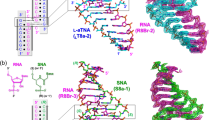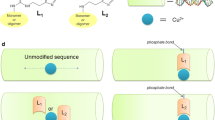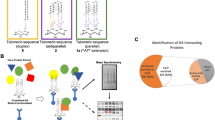Abstract
DNA ANALOGUES are currently being intensely investigated owing to their potential as gene-targeted drugs1–3. Furthermore, their properties and interaction with DNA and RNA could provide a better understanding of the structural features of natural DNA that determine its unique chemical, biological and genetic properties3,4. We recently designed a DNA analogue, PNA, in which the backbone is structurally homomorphous with the deoxyribose backbone and consists of N-(2-aminoethyl)glycine units to which the nucleobases are attached5–9. We showed that PNA oligomers containing solely thymine and cytosine can hybridize to complementary oligonucleotides, presumably by forming Watson–Crick–Hoogsteen (PNA)2–DNA triplexes, which are much more stable than the corresponding DNA–DNA duplexes5–7, and bind to double-stranded DNA by strand displacement5,8. We report here that PNA containing all four natural nucleobases hybridizes to complementary oligonucleotides obeying the Watson–Crick base-pairing rules, and thus is a true DNA mimic in terms of base-pair recognition.
This is a preview of subscription content, access via your institution
Access options
Subscribe to this journal
Receive 51 print issues and online access
$199.00 per year
only $3.90 per issue
Buy this article
- Purchase on Springer Link
- Instant access to full article PDF
Prices may be subject to local taxes which are calculated during checkout
Similar content being viewed by others
References
Hélène, C. & Toulmé, J.-J. Biochim. biophys. Acta 1049, 99–125 (1990).
Goodchild, J. Bioconjugate Chem. 1, 165–187 (1990).
Uhlmann, E. & Peyman, A. Chem. Rev. 90, 544–584 (1990).
Eschenmoser, A. & Loewenthal, E. Chem. Soc. Rev. 21, 1–16 (1992).
Nielsen, P. E., Egholm, M., Berg, R. H. & Buchardt, O. Science 254, 1497–1500 (1991).
Egholm, M., Buchardt, O., Nielsen, P. E. & Berg, R. H. J. Am. Chem. Soc. 114, 1895–1897 (1992).
Egholm, M., Buchardt, O., Nielsen, P. E. & Berg, R. H. J. Am. Chem. Soc. 114, 9677–9678 (1992).
Egholm, M. et al. J. chem. Soc. chem. Commun. 800–801 (1993).
Cherny, D. Y. et al. Proc. natn. Acad. Sci. U.S.A. 90, 1667–1670 (1993).
Borer, P. N., Dengler, B., Tinoco, I. Jr. & Uhlenbeck, O. C. J. molec. Biol 86, 843–853 (1974).
Freier, S. M., Burger, M. D., Alkema, D., Neilson, T. & Turner, D. Biochemistry 22, 6198–6206 (1983).
Vesnaver, G. & Breslauer, K. J. Proc. natn. Acad. Sci. U.S.A. 88, 3569–3573 (1991).
Orgel, L. Nature 358, 203–209 (1992).
Cech, T. Proc. natn. Acad. Sci. U.S.A. 83, 4360–4364 (1986).
Miller, S. L. Science 117, 528–529 (1953).
Oro, J. Biochem. biophys. Res. Commun. 2, 407–415 (1960).
Crook, S. T. Curr. Opinion. Biotech. 3, 656–661 (1992).
Hanvey, J. C. et al. Science 258, 1481–1485 (1992).
Nielsen, P. E., Egholm, M., Berg, R. H. & Buchardt, O. Anti-Cancer Drug Design 8, 53–63 (1993).
Freier, S. M., Albergo, D. D. & Turner, D. Biopolymers 22, 1107 (1983).
Maniatis, T., Fritsch, E. & Sambrook, J. Molecular Cloning: A Laboratory Manual (Cold Spring Harbor Laboratory Press, New York, 1982).
Author information
Authors and Affiliations
Rights and permissions
About this article
Cite this article
Egholm, M., Buchardt, O., Christensen, L. et al. PNA hybridizes to complementary oligonucleotides obeying the Watson–Crick hydrogen-bonding rules. Nature 365, 566–568 (1993). https://doi.org/10.1038/365566a0
Received:
Accepted:
Issue Date:
DOI: https://doi.org/10.1038/365566a0
This article is cited by
-
Splice-Modulating Antisense Oligonucleotides as Therapeutics for Inherited Metabolic Diseases
BioDrugs (2024)
-
Dynamic and static control of the off-target interactions of antisense oligonucleotides using toehold chemistry
Nature Communications (2023)
-
Peptide nucleic acid-zirconium coordination nanoparticles
Scientific Reports (2023)
-
Advances in MicroRNA Therapy for Heart Failure: Clinical Trials, Preclinical Studies, and Controversies
Cardiovascular Drugs and Therapy (2023)
-
Artificial genetic polymers against human pathologies
Biology Direct (2022)
Comments
By submitting a comment you agree to abide by our Terms and Community Guidelines. If you find something abusive or that does not comply with our terms or guidelines please flag it as inappropriate.



